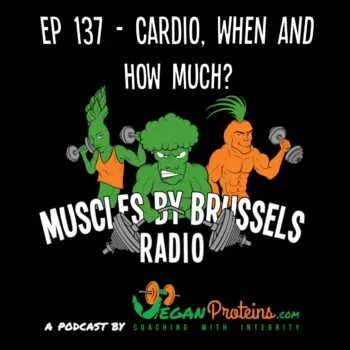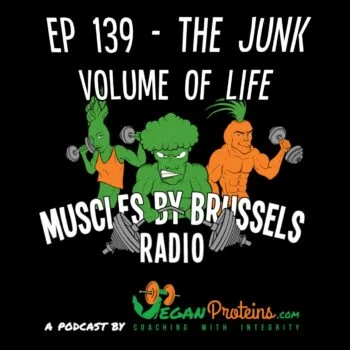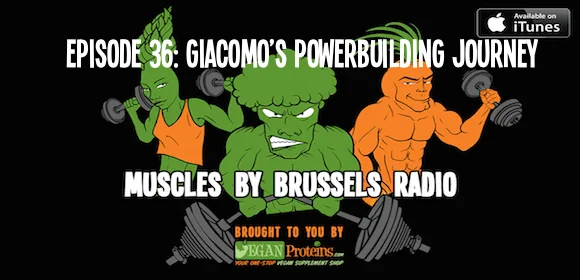For years, the fitness industry has been pushing the wrong message about cardio. “Cardio kills your gains!” “Only do cardio if you have to!” But is that really true? In this video, Giacomo breaks down how social media and bodybuilding culture shaped the way we think about cardio—and why it’s time to rethink everything.
Transcript:
We’re not gonna do cardio. Cardio is for suckers. Why would you do cardio? Lose your gains. All wrong!
What’s up everybody, this is Giacomo. Welcome back to the VeganProteins YouTube channel.
Today I want to talk about how the entire fitness industry got it wrong when it came to cardio. I’ve been vegan for 20 years. I’ve been coaching people for 15 years.
I’ve been involved in the fitness industry for 15 years and I have seen a lot of stuff happen. A lot of stuff happen and what I could tell you right now is we screwed up big time when it came to cardio recommendations. So let me walk you back to the very beginning when social media started to take a strong hold of culture in the fitness industry and I want to talk about cardio specifically today and give you some insight as far as to how this all went down.
Back in the day when Instagram was new, I’m dating myself, I know. Bodybuilders, powerlifters, crossfitters, strength-based athletes all got together and started sharing information, collaborating, borrowing off of each other’s information to figure out how to best program for athletes and how to make the best kinds of recommendations for their clients and for people in general who are interested in consuming different kinds of content when it came to fitness. Bodybuilders won the war.
It created blanket recommendations across the board for everyone, not just athletes, when it came to cardio. Bodybuilders felt like there was a specific kind of cardio that they needed to do to get the best results, to preserve muscle mass, to maximize performance and to improve recovery times. When a bodybuilder is not in competition prep, these recommendations no longer hold true and depending on where a bodybuilder’s start point is when they enter competition prep, these recommendations aren’t even the best ones.
When it comes to fat loss, when you’ve dialed it into nutrition and it’s time to start adding in cardio, the idea is to preserve as much of your energy for performing while you’re training and for recovering after training because you’re in a calorie deficit. So the idea was minimize the amount of cardio. So these were where the ideas were rooted when it came to blanket recommendations that I feel we all got wrong, honestly.
And the idea was this. If you don’t have enough time to do cardio and it’s time to start doing cardio in competition prep, start doing HIIT because it takes the least amount of time to do but it is the most taxing on the body. If you do have time, instead of doing HIIT, you should engage in zone 2 cardio, which is the fat burning zone, 65 to 70 percent of your target heart rate.
It takes a little more time to burn calories but it’s less fatiguing on your system. Then if you have a lot of time, what is ideal is to walk. Walking hardly creates any fatigue and it does burn calories but it takes a lot of time.
So the idea was depending on how much time you have, these are the three ways to prescribe cardio. Walking is a way to burn calories and create a thermic effect without producing fatigue. So it’s the holy grail of bodybuilding while preserving muscle mass.
And these recommendations spilled over into a year-round recommendations for bodybuilders, not just when they were dieting and extreme dieting for competition prep, not just when they were cutting or doing like a crazy competition prep. Year-round, this was the way to do it. And because there’s some evidence and truth to programming and prescribing cardio like this, other kinds of athletes and the fitness industry in general followed suit and was like, well bodybuilders are the best at preserving muscle mass and extreme deficit, so they have an argument that is valid as far as how to prescribe cardio.
And people who are into lifting want to maximize their gains and preserve muscle mass at all costs. So this was the blanket recommendation more or less across the board and here’s how it started to get fun. When it came to culture and social media helped influence and shape and model culture in the fitness industry, you had people talking about being on team no cardio and they were saying it in a prideful way.
We’re not gonna do cardio. Cardio is for suckers. You’re gonna lose your gains.
Why would you do cardio? And there was this valid argument behind it because of all this reasoning. Then on top of that, you did have bodybuilders heckling crossfitters saying, oh y’all are not gonna have as much muscle as us because you do cardio. It was kind of like this joke between crossfitters and bodybuilders.
Then you had bodybuilders and powerlifters heckling one another because powerlifters were like, well we don’t diet and cardio is absolutely ridiculous and pointless and we’re not doing any cardio either. When in reality, powerlifters still should do cardio too. There was also this kind of bonding between powerlifters and bodybuilders as far as their hatred of cardio.
So because of everyone’s hatred of cardio, people got lazy and when it came to doing certain kinds of cardio over say, I don’t know, working on your heart health, this kind of narrative became pervasive. We stuck on the idea that you don’t have to do cardio unless you absolutely need to to burn fat and when you do do cardio, you should find a way to make a lot of time to do your cardio and it should be more along the lines of walking. Of course there’s like hit if someone really likes high intensity cardio, they don’t have much time.
We got it all. Powerlifters wound up becoming fearful of doing cardio. They thought that it would get in the way of them increasing their totals.
Bodybuilders prescribed cardio improperly or at least talking about it the wrong way at the very least. Again, continue to shame people in the fitness world in general that came in the mainstream fitness world. Be like nah, no cardio and people just stop doing cardio.
They make decisions based on the information that’s out there. What we should have done was one, encourage everyone to do cardio year round and two, encourage cardio that is good for heart health. Simple as that.
Your max heart rate is a simple formula. You take the number 220 and you take your age and you subtract the two. I’m 44 years old.
I take 220. I minus 44. So that’s your max heart rate.
Now there are five different heart rate training zones. Zones one through five. Zone one is for warming up, cooling down, and recovery.
Zone two is for fat burn. That’s the zone that I’ve been talking about this entire time. Zone three is for cardiovascular endurance and you start to focus on your heart health.
And zone four is even more intense and then zone five is all out. And we have been shying away from prescribing people zone three through zone five cardio for quite some time and discouraging those who are doing zone three through zone five from doing that cardio and just being like well it might get in the way of your gains and then they wind up coming to their own decisions and doing a little less or doing it and thinking they’re not going to get quite the same results. Outside of say a bodybuilding competition prep and a client that is not adapted to doing zone three to five cardio and outside of a powerlifter who’s absolutely looking to maximize their gains at all costs.
Outside of those two scenarios zones three through zone five are incredibly helpful to program for clients and to think about doing and if you’re already doing them by all means do not stop getting your cardio on. It’s good for your heart health. Cardiovascular endurance is excellent for your heart health.
We’re not going to sit here and debate whether someone should focus on their health or being the best athlete they can be. Your health should not be compromised. Even if you have to work really hard to be as competitive as you can be it’s all the more reason to focus on your health because competing and being a high performing athlete comes at a cost and your health is one of the prices that you pay for being high performing athlete so you might as well focus on your heart health.
The other thing is why wouldn’t you want good cardiovascular endurance for the gains. When it comes to cardiovascular endurance for both powerlifters and bodybuilders when you get in zone two and preferably zone three you wind up being able to replenish your ATP stores faster and you improve your work capacity. If you don’t do cardio because you think that it’s going to cause you to not recover as fast and not be able to work as hard in the gym and it’s going to result in muscle loss when you’re not diving down to an extreme you’re going to wind up actually shooting yourself in the foot because you lose the ability to recover faster and perform better.
Yes, I’m speaking to you two powerlifters. This is stuff we’ve learned a long time ago. We haven’t spoken about it.
This stuff we’ve been doing with our clients for quite some time, many years. I would say at least five years but we haven’t spoken about it. I figured this would be a good video to put out there to make sure that we are putting this information out there because it’s really super duper important.
The one thing I would say about powerlifters for those of you who are competitive and who are looking to maximize your total and be as powerful as possible to get increased flow by as much as possible maybe it’s a better idea to stick to zone two cardio as opposed to zone three instead of longer periods of time doing it for shorter periods of time. Finally, the length of time that you’re doing cardio matters. So zone three for one to three sessions a week for 20 to 30 minutes is ideal for everyone including competitive bodybuilders.
For powerlifters, competitive powerlifters specifically, you’re looking at zone two one to two sessions for 15 to 20 minutes a week. You may want to consider doing some zone four and zone five if bodybuilding isn’t your only goal. Those are the recommendations.
I hope you enjoyed my backstory of how this all came to be and how the fitness industry got wrong and how you’re a part of that and how we’ve been doing things differently for the past five years. I hope this helps you. If you have any questions, if you have any comments, let me know.
Hope you enjoyed the video. I hope to catch you in the next one. Hit the like button, hit the subscribe button.
Let me know what you think about cardio goals for yourself and we’ll keep this conversation going.



